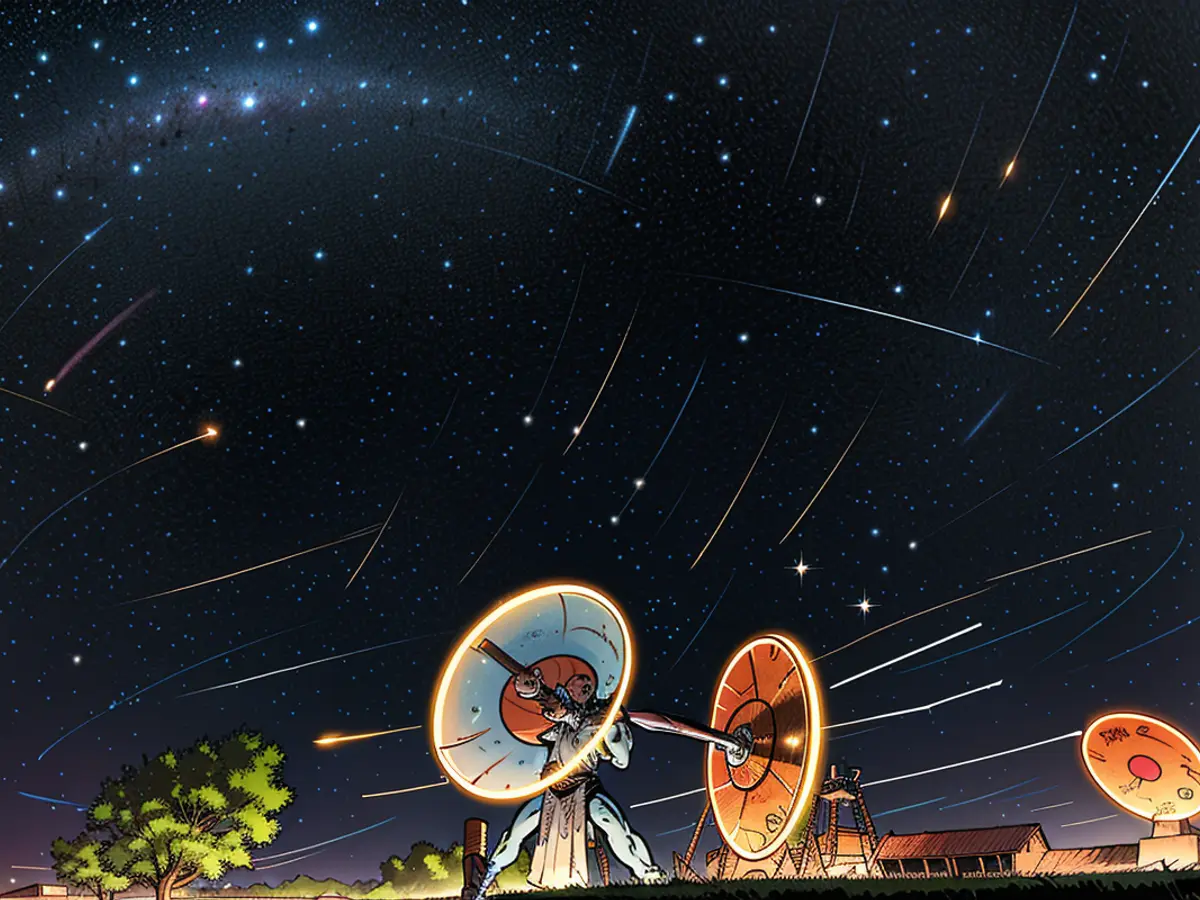Aquarids, Perseids, Saturn and summer triangle radiate
Pleasant night temperatures, maybe even a vacation: the best time to observe the starry sky. In July, the Summer Triangle and Saturn shine in full splendor. A constellation of four stars consisting of Mars, Jupiter, Aldebaran, and the crescent moon is also visible. The Aquarids and Perseids make their appearance.
The summer night sky unfolds its full beauty in July. Around the middle of the month, around 10 pm, the Summer Triangle stands high in the southeastern sky. It consists of the brightest stars from three constellations: Vega in Lyra, Deneb in Cygnus, and Altair in Aquila.
High in the western sky, Arcturus in Bootes shines. Arcturus and Vega are the brightest stars in the northern half of the sky. While Arcturus appears orange-red, Vega emits an intense blue-white light.
With a distance of 25 light-years, Wega is a neighboring sun to our Sun, making it a relatively close star. With a surface temperature of 10,000 degrees Celsius, it is much hotter than our Sun - and almost three times its size. It rotates very quickly. A rotation takes only half a day, while our Sun needs 25 days. Wega is therefore strongly flattened.
High above us is a small constellation of stars. It marks the head of the Dragon, which guards the North Star. In the northwest, the Great Wagon is sinking, while in the northeast, the constellation of the Lion is just rising.
Deep in the south, the Scorpion with its red heart star Antares crawls along the horizon. The Antares globe is enormous: In it, our inner planetary system finds comfortable accommodation beyond the Mars orbit.
Delta Aquarids and Perseids in the second half of the month
In the second half of the month, the Delta Aquarids appear. They are also called the Delta Aquarids because their radiant point is a little west of the star Delta in the Water Bearer. In the maximum on July 30, about 20 to 25 shooting stars per hour can be expected. The Aquarids (alternative spelling: Aquariids) are medium-fast meteors at about 40 kilometers per second, which is 144,000 kilometers per hour.
The best observation time are the hours after midnight. In the first part of the night, few Aquarids can be expected. From mid-July onwards, the first Perseids appear. They reach their greatest activity in August, which is known as the meteor shower month.

Fascinating constellation of Mars, Jupiter, Aldebaran, and the Moon
At the beginning of the night in July, the starry sky is first without bright planets. In the progressing night, Saturn appears first in the southeast. In early July, it rises an hour and a half after midnight, at the end of the month two hours earlier.
Currently, Saturn is located in the constellation of Water Bearer. In the telescope, the Saturn ring appears only slightly tilted, a particularly nice sight. Next year, the ring will be invisible for a short time when the Earth crosses the ring plane from north to south.
Mars is building up its morning visibility. It moves into the "Golden Gate of the Ecliptic," which is formed by the two open star clusters Hyades and Pleiades in the Bull. With this, it reaches the northernmost regions of the zodiac, while the Sun has already begun its descent towards the celestial equator. On the 1st, the Mars rise is a quarter of an hour after 2 am, on the 31st, already two hours earlier. The Mars brightness continues to increase slightly.
Jupiter approaches the Red Planet (Mars) significantly, but it won't catch up until mid-next month. On the 31st, an intriguing quadruple alignment occurs in the morning sky over the eastern horizon, consisting of Mars, Jupiter, Aldebaran, and the waning crescent Moon.
Venus passed behind the Sun in June. Our neighboring planet, Mercury, the swift messenger god and smallest of the eight planets, remains hidden in the Sun's rays in July.
Pluto takes 250 years to orbit the Sun
On the 23rd, Pluto, in the constellation of Capricorn, comes into opposition with the Sun from our perspective. Pluto and the Sun align in the sky. When Pluto was discovered at the Lowell Observatory in Flagstaff, Arizona, in the spring of 1930, it was considered the ninth and most distant planet.

After it was determined that it is only about 2373 kilometers in diameter, not even half the size of Mercury, and that other objects with similar dimensions were found beyond Neptune's orbit, it was reclassified as a dwarf planet by the International Astronomical Union in 2006.
Dwarf planet Pluto was assigned the planetoid number 134,340. Its moon Charon is half the size of Pluto itself. In recent times, four more moonlets have been discovered that accompany Pluto on its long journey around the Sun. Pluto and its five moons have been traveling for nearly 25,000 years to complete one orbit around the Sun. The peak of Pluto's exploration was the close encounter of the spacecraft "New Horizons" on July 14, 2015.
Besides numerous physical data, "New Horizons" provided fantastic images of Pluto and Charon's icy landscapes. On board was, incidentally, a little ash of Clyde Tombaugh, the now deceased Pluto discoverer. It is the first time in the history of astronomy that an astronomer has visited his discovered planet posthumously.
Pluto is currently 5092 million kilometers from Earth, which is 34 times the Earth-Sun distance. Light from Pluto takes four hours and 43 minutes to reach Earth. Similarly long were the travel times for the Pluto spacecraft "New Horizons" signals to reach Earth-based ground stations.
Earth at maximum solar distance
The new Moon enters on July 6 at 0.57 am. The full Moon phase will occur on July 21 at 12.17 pm, with the bright Moon in the constellation of Sagittarius. At this time, the full Moon takes the southernmost position of the entire year. On the 12th, the Moon reaches its farthest point in its orbit, with a distance of 404,362 kilometers. It is only 364,917 kilometers away from us on the 24th.
The Sun moves along the descending branch of its annual path. On the 20th, it enters the constellation of Cancer in the afternoon, and on the 22nd, it passes the winter solstice point, the beginning of the zodiac sign Cancer. The solar noon height decreases by five degrees. The solar transit time in Hamburg is reduced by one hour and 14 minutes, in Berlin by one hour and 9 minutes, in Cologne by one hour and 5 minutes, and in Munich by 56 minutes.
On July 5, the Earth reaches its maximum distance from the Sun in its elliptical orbit. On this day, we are 152,099,968 kilometers away from the ball of fire. The sunlight then takes eight minutes and 27 seconds to reach us. In early January, when the Earth takes its smallest distance from the Sun, the sunlight reaches us 17 seconds earlier.

The Summer Triangle, comprised of Vega, Deneb, and Altair, is joined by Saturn in July, shining bright in the southeastern sky. Venus, however, is currently hidden behind the Sun. The second half of the month brings the Delta Aquarids, with up to 25 shooting stars per hour expected on July 30.
In the morning sky, Mars is making its way towards the "Golden Gate of the Ecliptic," while Jupiter approaches Mars but won't catch up until mid-next month. A fascinating quadruple alignment occurs at the end of July, with Mars, Jupiter, Aldebaran, and the waning crescent Moon visible in the eastern horizon.
Further in the night sky, the constellation of Mars, Jupiter, Aldebaran, and the Moon is a sight to behold at the beginning of July. In the constellation of Capricorn, Pluto, once considered the ninth planet, will be in opposition with the Sun on July 23. The dwarf planet, which takes 250 years to orbit the Sun, has now five known moons, with Charon being half its size.
Education in astronomy is vital in understanding these celestial events. Astrology, on the other hand, relies on the positions of the planets and stars to make predictions about human affairs, a belief not universally accepted in the scientific community.







